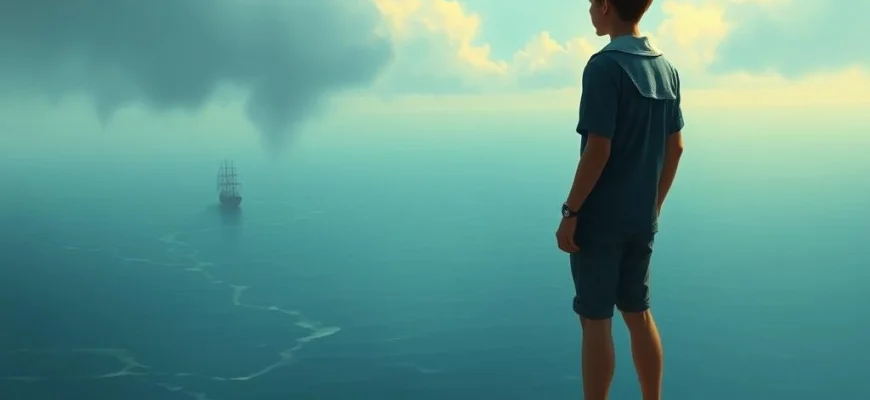If you were captivated by the haunting beauty and psychological depth of The Sailor Who Fell from Grace with the Sea (1976), this list is for you. Explore 10 similarly evocative films and shows that delve into themes of alienation, existential angst, and the clash between innocence and corruption. Whether you're drawn to its poetic visuals or its unsettling narrative, these recommendations will satisfy your craving for thought-provoking cinema.

Tokyo Story (1953)
Description: A quiet, deeply humanistic portrayal of generational disconnect and loneliness. The film's restrained storytelling and emotional resonance make it a timeless meditation on family and aging.
Fact: Often ranked among the greatest films of all time, it was initially a box-office failure in Japan. Its slow pacing was revolutionary for its era.
 Watch Now
Watch Now 
Ugetsu (1953)
Description: A dreamlike blend of ghost story and human drama, exploring ambition and the supernatural. The film's ethereal visuals and tragic undertones create a haunting, lyrical experience.
Fact: Widely regarded as one of the greatest films ever made, it won the Silver Lion at Venice. Its ghostly sequences were achieved with innovative lighting techniques.
 Watch Now
Watch Now 
Sansho the Bailiff (1954)
Description: A heartbreaking tale of familial separation and endurance under oppression. The film's stark beauty and emotional depth highlight themes of suffering and redemption.
Fact: The movie was based on a medieval Japanese folktale. Its final scene is often cited as one of the most moving in cinema history.
 Watch Now
Watch Now 
The Naked Island (1960)
Description: A silent, almost documentary-like portrayal of human struggle against nature. The film's minimalist approach and focus on endurance evoke a profound sense of isolation and resilience.
Fact: The movie has almost no dialogue, relying entirely on visuals and sound to tell its story. It was shot on a remote island with a non-professional cast.
 Watch Now
Watch Now 
Harakiri (1962)
Description: A searing critique of feudal hypocrisy and honor, told through a slow-burning narrative of revenge. The film's meticulous pacing and moral complexity mirror its themes of justice and despair.
Fact: The movie's climactic duel is one of the most brutally realistic in cinema history. It was remade in 2011, but the original remains a classic.
 Watch Now
Watch Now 
Onibaba (1964)
Description: A haunting exploration of human desire and moral decay, set against a bleak, atmospheric backdrop. The film delves into themes of survival, jealousy, and the supernatural, with striking visual symbolism.
Fact: The film's iconic use of tall, swaying grass creates an eerie, almost hypnotic visual rhythm. It was initially banned in some countries for its explicit content.
 Watch Now
Watch Now 
Vengeance Is Mine (1979)
Description: A brutal character study of a remorseless killer, framed by nonlinear storytelling and stark realism. The film's exploration of amorality and societal decay is both gripping and unsettling.
Fact: Based on the true story of serial killer Akira Nishiguchi. The film's fragmented narrative was groundbreaking for its time.
 Watch Now
Watch Now 
The Ballad of Narayama (1983)
Description: A visually stunning meditation on mortality, tradition, and the harshness of rural life. The film's unflinching portrayal of sacrifice and familial duty resonates with deep emotional weight.
Fact: The movie won the Palme d'Or at Cannes. Its theatrical, almost Kabuki-like staging contrasts with its raw, naturalistic themes.
 Watch Now
Watch Now 
Black Rain (1989)
Description: A harrowing depiction of post-war trauma and societal collapse, rendered with visceral intensity. The film's somber tone and focus on human suffering create a deeply melancholic atmosphere.
Fact: The title refers to the radioactive fallout after the Hiroshima bombing. The film was shot in stark black-and-white to emphasize its grim subject matter.
 Watch Now
Watch Now 
Kuroneko (1968)
Description: A poetic yet chilling tale of vengeance and the supernatural, blending folklore with stark human emotions. The film's shadowy cinematography and eerie tone amplify its themes of betrayal and retribution.
Fact: The movie was shot almost entirely on soundstages, giving it a theatrical, otherworldly feel. It’s often compared to a Japanese ghost story with a feminist twist.
 Watch Now
Watch Now 








